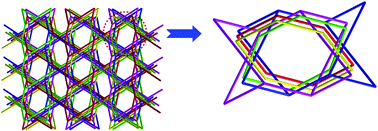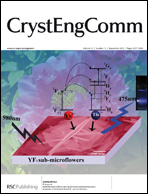A series of new metal–organic coordination complexes, [Zn(cpds)(H2O)2]n (1), {[Zn(cpds)(4,4′-bipy)]·6H2O}n (2), {[Zn(cpds)(bpe)]2·0.5(bpe)·4H2O}n (3), [Cu(cpds)(2,2′-bipy)(CH3OH)]2·2H2O (4), {[Cu(cpds)(4,4′-bipy)(H2O)2]·2.24H2O}n (5), {[Cu(6-sinic)(4,4′-bipy)0.5]·CH3OH·H2O}n (6), [Cd2(6-mna)2(phen)]n (7), and {[Cd(cpds)(bpe)]·2.2H2O}n (8) were prepared by self-assembly of disulfide derivative of the nicotinate, 6,6′-dithiodinicotinic acid (H2cpds) with transition metal ions in the absence of different N-donor ligands (4,4′-bipy = 4,4′-bipyridine, 2,2′-bipy= 2,2′-bipyridine, phen = 1,10-phenanthroline, bpe = 1,2-bis(4-pyridyl)ethene, 6-sinic = 6-sulfinto-nicotinate, 6-mna = 6-mercaptonicotinic acid). X-Ray structure analyses of 1–8 reveal their structure ranging from the discrete unit (0D) (4), one-dimensional (1D) (1, 5), two-dimensional (2D) (7), non-interpenetrating 3D porous coordination polymers (6, 8), 2-fold interpenetrated structure (2) to a 5-fold interpenetrating framework (3), which mainly due to the differences in the bridging modes of cpds2− and the effect of the secondary ligands. Interestingly, in the complexes 6 and 7, the starting H2cpds reagent is converted into new ligands (6-sinic in 6 and 6-mna in 7) under solvothermal condition viain situ cleavage of S–S bond. In addition, thermogravimetric analyses, X-ray powder diffractions and the fluorescent properties of complexes 1, 2, 3, 7, 8 have been investigated.


 Please wait while we load your content...
Please wait while we load your content...